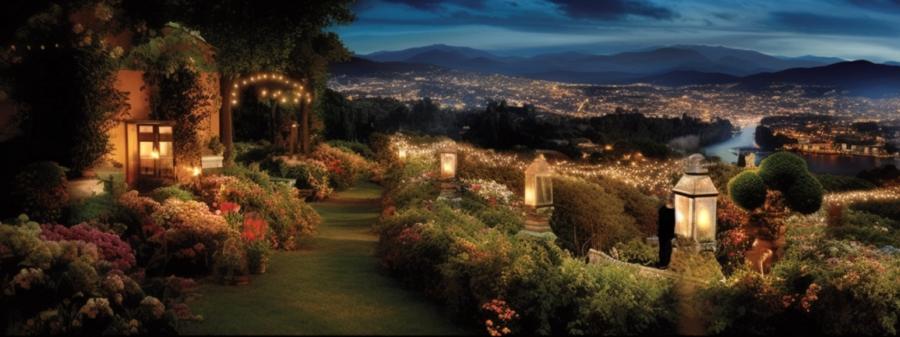Creating Night Gardens: Nature's Nocturnal Ballet

An Ode to the Night Garden
Ah, the night garden! A place where one can truly appreciate the finer things in life: the ethereal glow of moonlight caressing the petals of flowers, the bewitching fragrance of nocturnal blooms, and, of course, the seductive dance of shadows as they flit and undulate in the breeze. But what are the essential ingredients of this gloriously dark and mysterious realm? How does one go about creating such a beguiling playground for the senses? Fear not, for I shall guide you through the process, offering valuable insights and practical advice to help you better understand the tantalizing world of night gardens.Choosing the Perfect Canvas
First things first, you must choose the ideal location for your night garden. Consider the size of your outdoor space, as well as its exposure to moonlight. If your garden is vast, perhaps designate an area specifically for nocturnal pursuits, such as a secluded corner or a moonlit glade. Conversely, if your garden is small, allow the nocturnal elements to infiltrate the entire space, creating a sense of dark enchantment.The Importance of the Moon
One cannot underestimate the critical role the moon plays in a night garden. This heavenly body is the conductor of our nocturnal ballet, casting its silvery beams upon the stage and providing the perfect lighting for the performance to unfold. To make the most of the moon's generous offerings, consider the phases of the moon when planning your garden. Plant your nocturnal blooms so that they reach their peak during the full moon, when the garden will be bathed in the most potent lunar light.The Nocturnal Cast: Night-Blooming Flowers
The true stars of the night garden are, of course, the night-blooming flowers. These botanical beauties possess an almost supernatural allure, with their delicate petals unfurling as darkness descends and releasing their intoxicating scents into the night air. Some night-blooming flowers to consider for your garden include:- Moonflower (Ipomoea alba)
- Night-blooming jasmine (Cestrum nocturnum)
- Evening primrose (Oenothera biennis)
- Datura (Datura spp.)
- Night phlox (Zaluzianskya spp.)
- Four o'clock (Mirabilis jalapa)
- Night-blooming water lily (Nymphaea spp.)
The Scent of Seduction: Fragrance in the Night Garden
A night garden is not complete without an aromatic component. Indeed, the power of scent is heightened in the evening hours, adding yet another layer of sensory delight to your garden. Many night-blooming flowers, such as those mentioned above, emit their heady perfume after dark. Additionally, consider incorporating other fragrant plants, such as night-scented stock (Matthiola longipetala), gardenia (Gardenia jasminoides), and heliotrope (Heliotropium arborescens), to create a truly bewitching olfactory experience.The Dance of Shadows: Using Lighting to Enhance Your Night Garden
While the moon provides the primary illumination for your night garden, supplemental lighting can be employed to create dramatic effects and further enhance the garden's mystique. Use lights sparingly and strategically, placing them beneath trees or shrubs to cast intriguing shadows upon the ground or employing them to highlight specific plants or garden features. Solar-powered lights can be an excellent, energy-efficient option, as they will charge during the day and automatically illuminate your garden once darkness falls.Encouraging Nocturnal Wildlife
A truly successful night garden is one that attracts and supports a diverse array of nocturnal wildlife. These creatures, whether they be insects, birds, or mammals, will add life and movement to your garden, as well as contribute to the overall health of the ecosystem. Provide a source of water, such as a birdbath or a shallow pond, and consider incorporating plants that will provide food and shelter for your nocturnal visitors. For example, plant nectar-rich flowers to attract night-flying pollinators like moths and bats, and provide shrubs and trees for birds and other animals to roost and nest in.Enjoying Your Night Garden
Now that you have created your night garden, it is time to revel in its dark splendor! Take a leisurely stroll through the moonlit paths, inhale the intoxicating scents, and allow your eyes to adjust to the dim light, revealing the subtle beauty of your nocturnal paradise. Perhaps even consider hosting an evening garden party, inviting friends to admire your handiwork and partake in the bewitching performance that is nature's nocturnal ballet.Article kindly provided by yourhomengarden.org
Latest Articles
- The Step-By-Step Process of Turning a Garden Vision into Reality
- Rain Doesn't Fall Straight: Why Roof Shape and Wind Matter More Than You Think
- How Fire Pit Design Quietly Shapes Human Connection
- Invisible Passengers Who Never Pay the Fare
- When the Ground Has Opinions: Learning to Hear Tree-Soil Conversations
- When Windows Sweat: What Condensation Reveals About Your Home's Hidden Climate
- Vertical Micro-Oasis for Kitchen Herbs in Tight Urban Spaces
- Why Clean Workspaces Quietly Boost Creativity
- Color-Coding Your Backyard: a Homeowner's Guide to Safe DIY Marking
- Invisible Safety in Bathrooms that Still Feel Like a Spa
- How Orientation Shapes Your Extension's Energy Efficiency
- How Floor Patterns Change How a Room Is Perceived
- Angles, Curves and the Secret Life of Staircases
- How Outdoor Illumination Shapes Local Insect Populations
- Matching Wooden Outdoor Building Walls to Weather, Work and Whim
- The Real Value of Unbuilt Structures in Backyard Projects
- The Hidden Costs of Neglecting Yard Waste
- Why Your Fireplace Isn't Warming Your Space
- Why Your Driveway Is Secretly Plotting Against Your Garden
- Creating Calm Interiors That Still Feel Lived-In and Layered
- Interior Design
- Home Improvement
- Gardening
- Home Organization
- Home Maintenance
- DIY Crafts
- Kitchen and Dining
- Bathroom Design
- Home Security
- Home Automation
- Green Living
- Home Office
- Home Decor
- Garden Design
- Pet Care
- Home Technology
- Landscaping
- Home Energy Efficiency
- Home Cleaning
- Home Safety
- Home Exterior
- Home Insulation
- Home Buying
- Home Selling
- Renting
- Tradespeople
- Garage
- Bedroom
- Painting and Decorating
- Plumbing and Drainage

